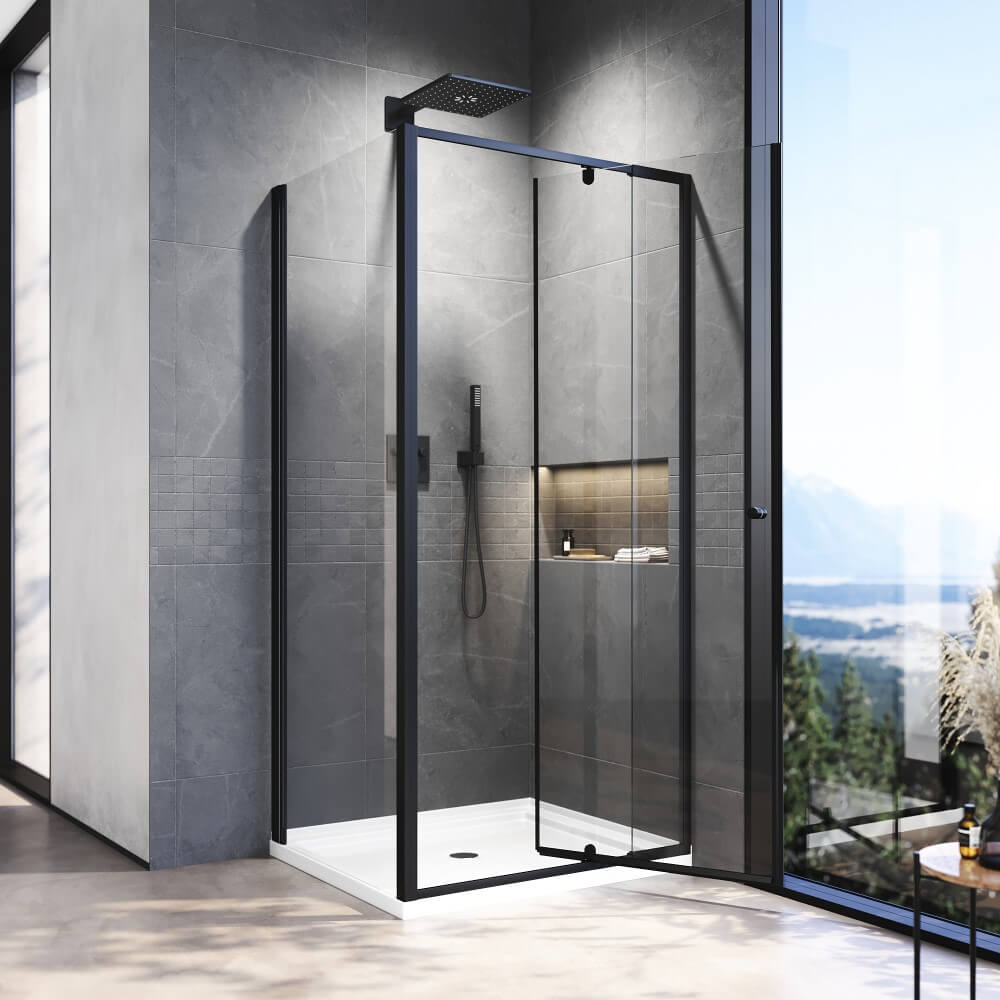Undertaking a bathroom renovation is an exciting project. The thought of a fresh, new space is motivating, but it can also be a significant source of anxiety, especially when it comes to the technical details. Few things can derail a project faster—and hit your wallet harder—than ordering a beautiful, custom shower enclosure only to find it doesn't fit.
A miscalculation of just a few millimetres can lead to gaps, leaks, improper door function, or a complete refusal from your installer to fit it. The resulting costs for re-tiling, plumbing adjustments, or a brand-new screen can run into hundreds, if not thousands, of dollars.
But here's the good news: this common source of stress is entirely preventable. This ultimate guide is designed to empower you, the Australian homeowner, with the knowledge and a step-by-step process for measuring your bathroom for a shower enclosure accurately. By following this guide, you'll approach your supplier or installer with confidence, ensuring you get a perfect fit and a seamless shower screen installation.
Why Perfect Measurement is the Foundation of Your Perfect Shower
The process of measuring for a shower screen is the single most critical step you can take before even getting a quote. It's the foundation upon which your entire shower enclosure project is built. An accurate measurement doesn't just ensure the glass fits; it ensures:
-
Water Containment: A perfectly sized screen prevents leaks that can damage your bathroom floor and substructure.
-
Aesthetic Appeal: Precise, gap-free installation looks professional and elevates the entire look of your bathroom.
-
Functional Integrity: Doors will swing or slide smoothly without catching or sticking.
-
Budget Adherence: You avoid the nightmare of unexpected costs for custom alterations or a replacement unit.
Investing 30 minutes with a tape measure now can save you weeks of hassle and a significant financial setback later.
Gather Your Tools: Your Measuring Kit for Shower Enclosure Success
You don't need a tradesperson's full toolkit for this job. Gather these simple items, and you'll be ready to measure like a pro:
-
A Quality Metal Tape Measure: Avoid cloth or fibreglass tapes that can stretch. A sturdy, retractable metal tape is essential for accurate shower measurements.
-
A Large Spirit Level: A 600mm or longer level is ideal for checking how straight your walls and floors are.
-
A Notepad and Pen: For meticulous recording.
-
A Pencil: For making light marks on walls if needed.
-
A Calculator: For any quick conversions or checks.
-
(Optional) A Laser Measure: Great for long distances and solo use, but a tape measure is perfectly sufficient.
Golden Rules for Measuring Your Shower Enclosure
Before we take a single measurement, internalise these four golden rules. They are the bedrock of avoiding shower screen measuring mistakes.
-
Measure in Millimetres (mm): The building and manufacturing industry in Australia works exclusively in millimetres. Using centimetres or inches introduces a risk of conversion errors.
-
Measure Twice, Order Once: This old adage is non-negotiable. Triple-checking your figures is encouraged. Have another person review them if possible.
-
Never Assume Walls are Straight or Corners are Square: In almost all homes, walls tilt (are "out of plumb") and corners are not perfect 90 degrees. We will measure for this.
-
Record Everything Clearly on a Rough Sketch: A simple diagram of your shower area with all measurements noted will be your single most important reference document.

Your Step-by-Step Guide to Measuring a Shower Enclosure
This is the core of the guide. Follow these steps methodically for a foolproof shower enclosure measurement.
Step 1: Create a Basic Floor Plan Sketch
Start by drawing a simple bird's-eye view of your shower area. Note all walls, the opening where the door will be, and the location of any fixed objects like taps, showerheads, or niches. This sketch doesn't need to be to scale; it's a visual notepad.
Step 2: How to Measure Shower Enclosure Width
This is where most mistakes happen. Do not just take one measurement.
-
For a rectangular alcove shower, measure the width at three points:
-
Along the floor (the base width).
-
At approximately 1000mm high (chest height).
-
Along the top, where the screen or rail will sit.
-
-
Crucial Tip: Record all three figures. The shower enclosure size you provide to your supplier should be the smallest of these three measurements. This ensures the screen will fit at its tightest point. The difference between these numbers tells you how "out of plumb" your wall is.
Step 3: How to Measure Shower Enclosure Height
Similar to width, height can vary.
-
Measure from the finished floor surface (including tiles) to the top of where the screen will go.
-
Take this measurement on both the left and right sides of the opening.
-
Again, use the smallest of these two measurements for your official shower screen height.
Step 4: Checking for Square and Level
This step is critical for preventing unsightly and leaky gaps, especially for quadrant shower enclosures or corner shower units.
-
Checking for Level: Place your spirit level on the shower floor and along the wall where the top of the screen will sit. See if bubbles are centred. An unlevel base can cause water to pool incorrectly.
-
Checking for Square (The 3-4-5 Method): This is the professional's trick. In the corner of your shower, measure 300mm along one wall and make a mark. Measure 400mm along the adjacent wall and make a mark. The diagonal distance between these two marks should be exactly 500mm if the corner is perfectly square. If it's not, you have an out-of-square corner, and this must be communicated to your supplier.
Step 5: Measuring for the Shower Door and Pivot Space
If you're choosing a pivot shower door, functionality is key.
-
Measure the internal and external clearance needed for the door to swing open fully.
-
Ensure it won't hit your toilet, vanity, bathroom door, or other obstacles.
-
Consider if a sliding shower door might be a better option for a compact space.
Step 6: Identifying and Measuring Obstructions
Note the exact location of any fixtures.
-
For shower taps and mixers, measure the distance from the adjacent wall and from the floor.
-
For shower niches, measure their width, height, and depth, and note their precise location.
-
This information ensures glass panels or doors won't conflict with these features.
Costly Measuring Mistakes to Avoid with Your Shower Screen
Let's be blunt about where things go wrong. Steer clear of these common bathroom renovation measuring errors:
-
Mistake 1: Assuming New Walls are Perfectly Straight. Even in new builds, walls can be out. Always measure at multiple points.
-
Mistake 2: Measuring at the Wrong Height. Relying on a single width measurement is a recipe for disaster.
-
Mistake 3: Forgetting to Account for Door Swing and Clearance. A beautifully sized screen is useless if the door can't open.
-
Mistake 4: Not Factoring in the Thickness of Tiles. Are you measuring before or after tiling? Your measurements must be for the finished surface.
-
Mistake 5: Confusing the Base Size with the Screen Size. For alcove showers, the screen size is often different from the shower base size. Always measure the actual space the glass will occupy.
Measuring Different Shower Enclosure Types
The basic principles remain the same, but here are some specifics for common shower enclosure types.
How to Measure for a Quadrant Shower Enclosure
A quadrant shower enclosure fits neatly into a corner. You need to measure the two wall lengths (as per Step 2) and the radius. The supplier will typically specify the radius (e.g., 900mm radius quadrant), but checking the squareness of the corner (Step 4) is paramount here.
How to Measure for a Rectangular/Alcove Shower Enclosure
This is the most common type. Follow the core steps for width, height, and depth meticulously. The key is the three-point width and two-point height check to account for any bowing in the walls.
How to Measure for a Shower Screen in a Bathtub Recess
Measure the total length of the bath at the top, where the screen will sit. Also, check if the bath is level from end to end. Bathtubs can have a slight slope for drainage, which needs to be considered for a shower bath screen installation.
How to Measure for a Walk-In Shower Enclosure
For a walk-in shower enclosure, you're typically measuring fixed glass panels. You'll need to measure the height and length of each panel location. Pay extreme attention to the floor level, as any slope will affect the plumb of the glass and the effectiveness of the drainage.
Your Pre-Order Shower Enclosure Measurement Checklist
Before you finalise your order or even get a quote, run through this checklist:
-
All my measurements are recorded in millimetres (mm).
-
I have measured the width at the floor, middle, and top.
-
I have measured the height on both the left and right sides.
-
I have checked the squareness of the corners using the 3-4-5 method.
-
I have checked the floor and walls for level.
-
I have confirmed the door swing clearance for pivot doors.
-
I have measured and noted the location of all obstructions (taps, niches).
-
I have double and triple-checked all measurements.
-
My rough sketch is clear and includes all measurements and notes.
When to Call a Professional for Your Shower Enclosure
While this guide empowers you to take accurate measurements, some scenarios call for a professional's eye. Consider calling a professional shower screen installer if:
-
Your walls are severely out of plumb (a variance of more than 10mm).
-
You are planning a complex, frameless shower screen or a structural glass installation with minimal framework.
-
You are dealing with a completely custom, non-standard shape.
-
You have followed the steps but still feel unsure about your measurements.
Ready to Find Your Perfect Shower Enclosure?l
Now that you're armed with confidence and accurate measurements, the next step is to explore the perfect shower enclosure to bring your vision to life.
At Elegant Showers, we understand that a successful bathroom project is in the details. We don't just supply premium, high-quality shower solutions; we provide complete peace of mind. Our team of professional consultants is ready to review your measurements, discuss your design aspirations, and guide you through our extensive range of enclosures—from sleek frameless screens to practical sliding doors—ensuring a flawless fit and a stunning result.
Visit us today at elegantshowers.com.au to browse our collections and book your professional consultation. Let's build your dream bathroom, together.





